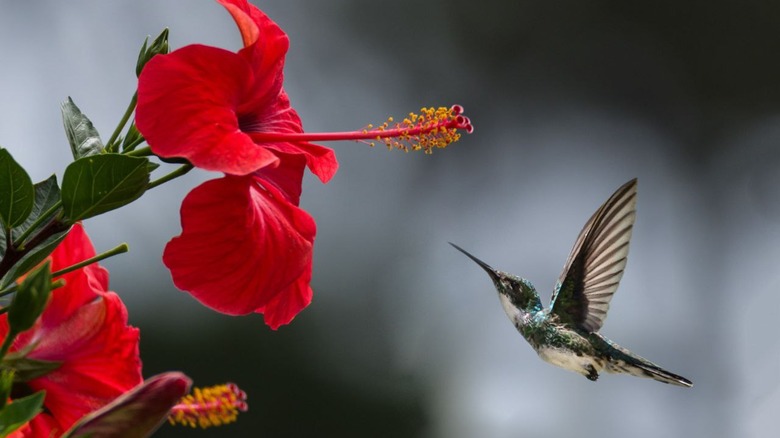Why You Should Add A Hibiscus Flower To Your Hummingbird Feeder
Hummingbirds bring joyful noise and flashes of color to porches and patios all summer long. Whether you're just getting started in your efforts to attract hummingbirds to your yard or you're a seasoned enthusiast, there's no shortage of tips and best practices for keeping these beautiful creatures nearby. This year, try incorporating hibiscus flowers in or near your feeder. Hibiscus flowers attract hummingbirds with their vibrant colors, and they provide an additional nectar source.
Some hummingbird lovers pick hibiscus flowers, rinse them, and add them directly into their feeder after removing the pistil and stamen to avoid clogging. This method can be difficult to upkeep since the flowers can mold inside the container, which means you'd need to clean the feeder very frequently. The perk of this method is that instead of a feeder full of clear water (food coloring is dangerous to hummingbirds), you'll attract more birds by adding that splash of color with flowers. To get around the mold issue, you could swap real hibiscus flowers for silk flowers instead. Another method for using hibiscus to draw these fluttering friends to your patio is to simply grow hibiscus near your feeder. Place pots of red hibiscus close to your feeders, or even position hanging pots at the same level as your feeder. This way, the hummingbirds will swoop in toward the vibrant pop of red and will have plenty of options to sip from between your sugar water and the nectar of the hibiscus.
How to grow hibiscus
Whether you're placing flowers directly into your feeder or you're using potted hibiscus, you'll need to grow these stunning blooms. To start, determine your yearly plans for your hibiscus plant. Do you prefer to grow it in a container and bring it inside during the winter? Would you prefer a perennial that dies back each winter but returns in the spring? Is it best for your patio design if you simply start over with a tropical variety each year?
From there, choose which species best suits your local climate and your needs. Mostly, you need to decide whether you'll grow tropical hibiscus or hardy hibiscus. As the names suggest, tropical hibiscus prefers a warmer climate while hardy hibiscus can be grown as a perennial in many zones. Within those categories, there are several species to choose from. For example, hibiscus hybrid, commonly known as Rose Mallow, is hardy in USDA zones 4 to 9. On the other hand, the tropical variety Hibiscus rosasinensis is only hardy in zones 9 to 11 — but its vibrant red blooms are well worth the possibility of having to replant! Once you've chosen the perfect hibiscus variety for your climate and priorities, determine the best time of year to plant your hibiscus. This will depend on your zone and the variety you've selected. For example, if you're planting hardy hibiscus, you'll likely opt for springtime planting. The majority of hibiscus varieties prefer to grow in full sun, and it's best to keep the soil moist but not overly saturated.
Things to consider
Once you've incorporated showy hibiscus into your hummingbird feeder setup, you'll notice an abundance of pollinators visiting your patio. In addition to hummingbirds, hibiscus also attracts butterflies and specialized bee species. When you welcome one, you welcome them all, so if you're sensitive to the more buzzy, stinging pollinators, you might choose a spot with some space from your sitting area for your feeder and hibiscus setup.
Whether you're depositing flowers into your feeder or simply hoping to attract hummingbirds with them, refrain from using pesticides on your flowers. Many pesticides are extremely harmful to hummingbirds as well as other pollinators. Another way you can help protect hummingbirds from toxicity is to thoroughly clean your feeder consistently. Since mold can form quickly in the heat, aim to clean your feeder twice per week during hot weather and once per week in cooler months. If you're growing hibiscus near your feeder but you're still not seeing the hummingbird activity you'd like to, don't be afraid to experiment! You could purchase a few more feeders to test out different locations — the birds may feel too exposed to predators at the current location of your feeder, or maybe the area is just too noisy. You can also grow other red, tubular flowers to welcome them in, and research the native flower species in your area to match their appetite.


